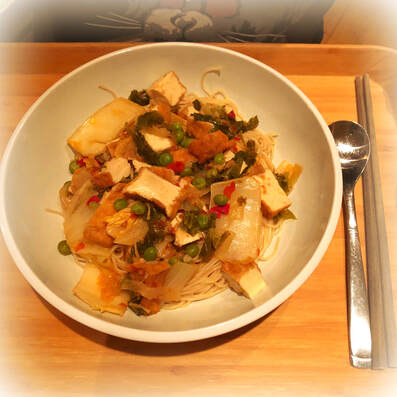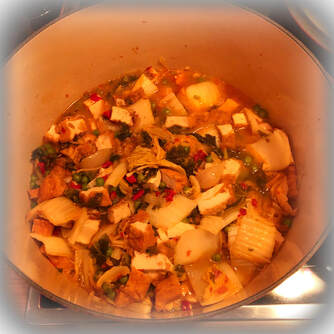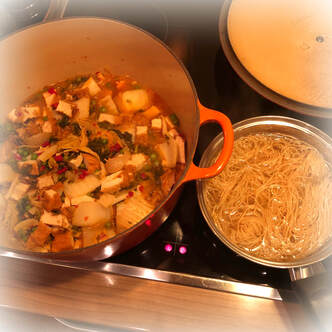|
On the subject of food and nutrition during Yoga Therapy training, our lecturer made a statement which really took me by surprise – she advised that instead of throwing out vegetables that are starting to yellow, we may want to consider eating them as the process of yellowing actually produces certain nutrients that aren’t present when their green! My partner can attest, I’ve always been one to try to use up every leftover ingredient in the fridge, past their sell-by date, so long as they’ve not began to mould. The post-war generation of Chinese are big on not wasting food. This attitude has been passed down from grandparents to parents, then parents to children; though it’s doubtful if its influence continues with the new generation, it’s certainly etched into my mindset. I still remember vividly – after emptying what’s leftover in the rice cooker – my elderly nanny used to pour hot water down the cooker dish. The purpose is to soften the remainder grains that were caked to the walls of the dish. She would scrape the grains off and eat them like a rice congee. Not a single grain ever goes to waste, as she often teaches us the importance of appreciating the food that’s available to us, but also to understand how painstaking it actually is to grow and produce rice. The need to not waste, perhaps it’s one of the reasons why, the Chinese have developed recipes and cooking methods that are particularly suited to turning stale ingredients delectable. Braising is a great example, less common in English cookbooks but certainly a method that appears in French cooking. It’s uncertain who originated the technique but it’s one that serves this purpose well! In braising, you sautéed the ingredients at high heat for a quick moment and then finish the dish by covering and simmering it, in a small amount of liquids, for a longer period. Flavours between ingredients and condiments are infused and enriched by one another with this method of cooking, and the results are usually rich in flavour.  ~ A Braised Pot of Leftovers ~ *All of the ingredients used here were headed for the compost bin. They were remaining quantities from other recipes. As such, the quantities for this dish can vary and you can always add/remove ingredients that are (un)available. Ingredients – 1 x White Onion (diced in chunks) 3 x cloves of garlic (chopped up finely) 2 x red chillies (roughly chopped up) Kale (roughly chopped, stalks removed) Chinese Leaf (chopped in large pieces) Firm Tofu (diced in large cubes) Frozen Peas Miso Paste Douban Jiang aka Chilli Bean Sauce (made from fermented soy beans and chilli) Stock (chicken or vegetable) Sesame Oil Brown or Cane Sugar Cooking Oil *Optional ~ Handful of dried shrimp (finely chopped) Handful of dried scallops (crumbled) 1. On the hob – at medium-high setting - heat the cooking oil in a deep dish/cooking pan for 1-2 mins 2. Once the oil is hot, add the garlic, onions, chillies, *dried shrimp and scallops (optional ingredients) that you’ve prepared. Toss them in the oil and fry for a few seconds, taking care not to let them burn. 3. Turn the heat down. Add a dash of water as you put the lid on and let the ingredients soften inside. 4. Add the kale and toss it well with the rest of the ingredients. Put the lid back on and let it simmer for a minute. 5. Then the Chinese leaf – just as above – stir it in thoroughly with the rest. Put the lid back on and simmer for a couple of minutes. 6. Mix in the frozen peas next. Add a splash of chicken/vegetable stock, cover and simmer, this time for longer 7. Check the pot regularly, lifting the lid and giving the ingredients a stir so they don’t burn or stick to the bottom. You want to make sure that it’s simmering and not boiling. The ingredients should always be cooking in a small amount of liquids. 8. With braising, the ingredients are cooking in a covered pot so the liquids are evaporating, condensing on the lid and returning back to the ingredients. At a low heat, you are essentially cooking the foods in their own fluids. 9. Add more stock if the liquid is drying up, you probably will need to top up 2-3 times during the process. If the liquid’s evaporating all the time, it could mean that the heat is too high and you may want to turn it down. 10. When you notice that the vegetables have softened, add the condiments – the chilli bean sauce, miso paste, sesame oil and a bit of brown/cane sugar. Salt, if desired. 11. Mix in the tofu cubes and stir in well with the rest of the ingredients. 12. Cover and simmer for a few minutes; test to see if it’s ready to serve – the Chinese leaf is a good indicator, it captures flavours well and should taste like an infusion of the flavours in the pot. 13. Serve with rice or noodles. *A section of this post appears on my IG, click on the icons below to follow me!
0 Comments
Leave a Reply. |
Hongyi the yogiFull-time yoga teacher & trainee yoga therapist in London. Eager to share, eager to learn! Archives
July 2021
Categories |



 RSS Feed
RSS Feed
